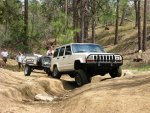MTVR, off the top of my head (I'm not the OP...), Jeep Grand Cherokee 2011+, a bunch of LR's, Ford Expeditions... Pathfinders...
From my suspension and chassis engineering brain: Looking at similarly equipped stock-ish vehicles, one with a solid axle (Front or rear) is generally going to have quite a bit more articulation than IFS or IRS. This is because most of the vehicles we're discussing have around 8" of total travel vertically. (Obviously not an MTVR, but it's a bit outside this discussion...)
The reason a solid axle has more travel in roll is because the stops generally limit travel about 1' or so inboard of the tire position. As the axle articulates, the tire actually moves 10" or more becuase of the axle angle swinging it farther up or down. Independent suspension only moves 8" ever, it doesn't matter if it's "articulation" or straight jounce.
Also playing a part in the traction scenario is that the "wheel rate" (spring rate at the tire). With IFS it is always the same. With a solid axle, it is highest (IE, matches the actual rate of the coil or leaf spring) in straight compression of both sides at the same time, but the effictive rate at the tire in roll (articulation) is actually quite a bit lower than the spring rate. This is again because the spring is inboard of the tire by 1' or so, which means it is effectively acting on the tire through a 1' lever. This lower roll rate does a far better job of keeping weight distributed equally on the tires than IFS does.
Which takes us to mobility... In my experience with OE type vehicles, the idea that with lockers, traction control, etc, articulation doesn't matter is fairly incorrect... Even with lockers, if you're lifting tires, they're not providing traction. If you don't have more even ground contact pressure, it can be far more difficult to climb a ledge type event. With lockers or TC, you may still get through an obstacle, but better articulation and more even ground contact pressure get you through with far less drama or stress to vehicle components.
This is the dilemma of the adjustable height suspensions that can be found on LR's and Jeep GC's... You can make the vehicle higher for clearance, but this is at the expense of compliance because the droop travel of the suspension is reduced by however far the vehicle lifts itself. Reduced droop travel means you're lifting tires, teetering around, relying on TC or lockers, putting more stress on the tires that have traction, etc, rather than just driving through with all the tires on the ground. Therefore, if clearance isn't an issue, my experience has been that it's often better (ride, mobility, etc) to leave the suspension lower so the tires stay more evenly planted.
Hopefully this helps...

